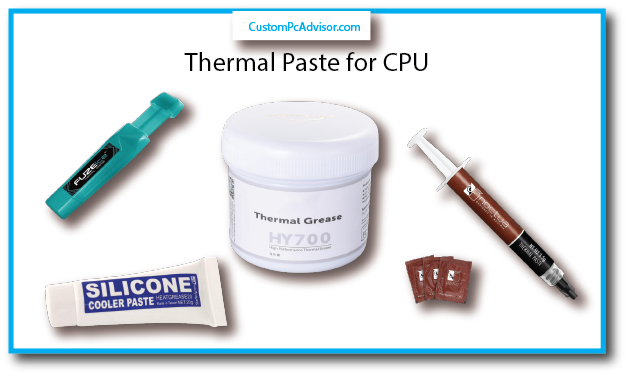Hey there, computer lovers! Let’s dive into the world of thermal paste, the important hero that keeps your computer running cool. This stuff isn’t your CPU’s sandwich spread; it’s
more like a guardian that prevents your computer from turning into a hotbox on overdrive. Think of it as the friendly, protective bond between your CPU and its trusty partner, the
heat sink. In this guide, we’ll reveal the secrets of applying thermal paste like a pro, and Thermal Paste for CPU, breaking it down into simple steps and Saying bye-bye to
overheating and welcoming a happier, speedier computer!
1. The Ultimate Guide to Thermal Paste:
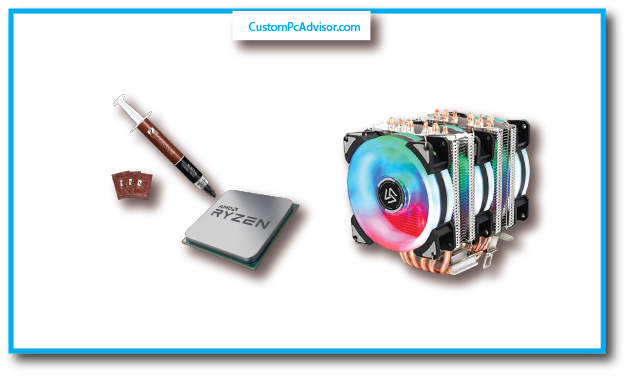
Hey there, tech enthusiast! We’re about to embark on an exciting journey into the world of thermal paste, or as some call it, the ‘magical heat-conductive goo’ for your CPU. 🧙♂️
What’s the Deal with Thermal Paste?
You see, thermal paste isn’t just your everyday goo – it’s like the unsung hero of your computer’s cooling system. Imagine it as the trusty bridge between your CPU and the
heatsink, making sure heat travels
quickly and efficiently. If it’s missing in action, your CPU could throw a fit – overheating and causing mayhem.
Why Is Thermal Paste So Important?
Well, your CPU is a heat-generating powerhouse, and it needs to stay cool to perform at its best. Thermal paste is like the cooling wizard, ensuring your CPU doesn’t turn into a hot potato.
Without it, you might experience performance slowdowns, system crashes, or even say goodbye to your CPU forever! 😱
Mastering the Art of Thermal Paste Application
Applying thermal paste isn’t rocket science, but it’s essential to get it right. First, make sure your CPU and heatsink are squeaky clean.
Think of it as a spa day for your computer components – they deserve it. A dash of isopropyl alcohol and a cotton swab will do the trick.
Now, comes the fun part – applying the paste. Picture a tiny pea or a grain of rice, and that’s the right amount. Spread it evenly, like butter on your morning toast (but don’t eat it, please!).
When you attach the heatsink, make sure it’s snug but not Hulk-smash tight – gentle pressure is the name of the game.
Choosing Your Thermal Paste For CPU
There’s a thermal paste for everyone, and compatibility is the key. It’s like choosing the right superhero for the job. Make sure it suits your CPU and heatsink.
Also, keep an eye on thermal conductivity; it’s like the speed at which your superhero gets the job done. A higher score means faster heat transfer – a win-win!
For most folks, a thermal paste with a thermal conductivity of 5 W/mK or higher is like having a superhero on your side.
But if you’re pushing your CPU to the limits, consider a thermal paste with even more power.
When to Change Your Thermal Paste?
Think of thermal paste as your car’s oil – it doesn’t need changing every week. Typically, every 1-2 years is just fine.
But, if your CPU starts throwing a tantrum and overheating, it might be time for a change.
In conclusion, thermal paste is the hero of CPU cooling, and understanding it is like having a trusty sidekick in your tech adventures.
Choose wisely, apply it with love (and perhaps a bit of flair), and your CPU will stay cool and happy. So go forth,
keep your CPU chill, and may your gaming sessions be lag-free and your workdays breeze by.
Quick Guide Highlights:
| Topic | Key Point |
|---|---|
| What’s the Deal with Thermal Paste? | It’s the CPU’s trusty bridge to the heatsink. |
| Why Is Thermal Paste So Important? | Overheating can wreak havoc on your CPU. |
| Mastering the Art of Thermal Paste Application | Clean, apply, and attach – easy as pie. |
| Choosing Your Thermal Paste Sidekick | Compatibility and conductivity matter. |
| When to Change Your Thermal Paste? | Every 1-2 years or when your CPU gets grumpy. |
2. How to Apply Thermal Paste Like a Pro
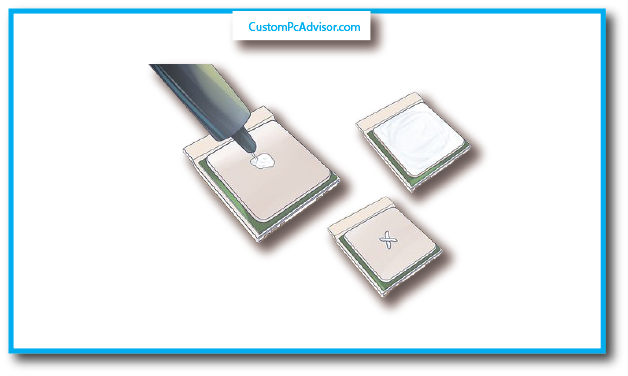
we’re diving into the exciting world of thermal paste application. It might not sound thrilling, but trust me, it’s the secret sauce to keep your CPU icy cool.
Cleanliness is Next to Coolness
Before you get all artsy with thermal paste, give your CPU and heatsink surfaces a little spa day. Think of it as scrubbing away the CPU’s worries.
Grab a cotton swab and some isopropyl alcohol to make ’em squeaky clean.
Pea-Sized is Perfect
Now, the fun part! Grab your thermal paste and remember, you’re not painting a masterpiece. A pea-sized amount is your golden ticket.
Think of it as adding just the right amount of frosting to your cupcake.
Spread the Love, Not the Paste
Gently spread the paste evenly over the CPU. Use your finger or another cotton swab. Don’t go overboard with your spreading skills – we’re not frosting a giant cake here.
Overdoing it can lead to paste oozing out, and that’s a big no-no.
Attach the Heatsink with Care
Place the heatsink on your CPU, ensuring it’s seated evenly. No need to Hulk-smash it down; a gentle touch will do.
You’re like a CPU whisperer, making sure there’s no pressure on your beloved CPU.
Say Goodbye to the Excess
If there’s extra paste trying to sneak out, don’t panic. Use a cotton swab and some isopropyl alcohol to tidy up the mess. It’s like wiping away the crumbs after a delicious meal.
3. Choosing the Right Thermal Paste for Your CPU:
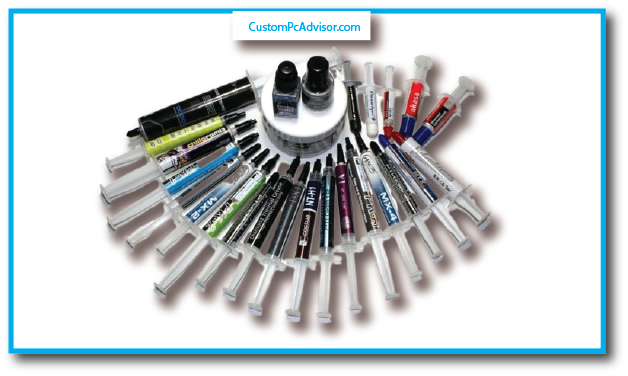
we’re delving into the fabulous world of thermal paste. Think of it as the ‘icing on the CPU cake.’ Let’s keep it easy, and breezy,
Coolness Factor 101: What to Look For
When you’re hunting for the perfect thermal paste, think of it as speed-dating your CPU cooler. Here are the deets:
| Factor | Coolness Expert Tip |
|---|---|
| Thermal Conductivity | High is hot (wait, no, it’s not!) – it keeps your CPU cool. |
| Viscosity | Thick or thin? Pick your paste personality. |
| Curing Time | Some like it hard – curing time can make a difference. |
| Compatibility | CPU compatibility is crucial – don’t break their hearts! |
| Price | Budget-friendly or splurge – find your match. |
Top Picks of 2023: The ‘Dateable’ Thermal Pastes
- Noctua NT-H1: It’s like the perfect partner – high thermal conductivity, low viscosity, and takes its sweet time to cure. Plus, it won’t empty your wallet.
- Arctic MX-5: Similar to Noctua, but with a little less ‘conductivity charm’ and a shorter curing time. Still affordable and quite the catch.
- Thermal Grizzly Kryonaut: This one’s the rockstar of thermal conductivity, but it’s a bit of a diva to apply and a bit pricey. If your CPU’s a superstar, it might be worth it.
- Corsair XTM50: A great all-around choice, balancing conductivity, viscosity, and curing time. And it won’t make you break the bank.
Should You Spend Money on Branded Thermal Paste
If you’re supercharging your CPU or using a fancy cooler, you can go all out with something like Thermal Grizzly Kryonaut. It’s like treating your CPU to a luxurious Cooling
But for most people, a thermal paste with a thermal conductivity of 5 W/mK or higher is like putting on a warm and comfy hoodie on a cold day – it’s just the right choice.
Show Some Love to Compatibility
Picture this: Your CPU and cooler are like a tech power couple. Make sure they’re a match made in heaven by checking the manufacturer’s compatibility info. No CPU breakup dramas, please!
The Grand Finale: Application
Once you’ve picked your ‘thermal date,’ follow the package instructions. It’s like following a recipe – apply evenly, don’t overdo it, and keep it clean.
By choosing your thermal paste wisely, you’re setting your CPU up for a ‘cool’ romance and keeping those temperatures down.
Here’s to a happy CPU and high-performance adventures in the tech realm!
Thermal Paste Decision-Making Cheat Sheet:
| Factor | Pro Tip |
|---|---|
| Thermal Conductivity | Higher is cooler, keep it under 5 W/mK. |
| Viscosity | Thick or thin, choose your ‘paste personality.’ |
| Curing Time | Some like it hard (cure time can matter). |
| Compatibility | CPU compatibility is a must. |
| Price | Your budget’s the boss – find your match. |
4. Thermal Paste Comparisons:
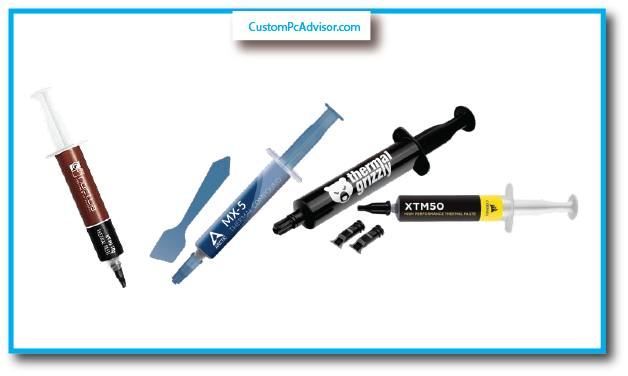
we’re about to witness the epic showdown of thermal pastes. These little wonders are like the secret sauce to keep your CPU chill.
But don’t worry, I won’t bore you with complex jargon; we’re here for some tech fun!
The Cool Comparisons
| Thermal Paste | Thermal Conductivity (W/mK) | Viscosity (Pa·s) | Curing Time | Price |
|---|---|---|---|---|
| Noctua NT-H1 | 8.5 | 95 | Long | Affordable |
| Arctic MX-5 | 8.5 | 85 | Long | Affordable |
| Thermal Grizzly Kryonaut | 12.5 | 120 | Short | Expensive |
| Corsair XTM50 | 8.5 | 100 | Long | Affordable |
And the Winner Is…
In the thermal conductivity department, the “Thermal Grizzly Kryonaut” takes the crown with a whopping 12.5 W/mK. It’s like having a race car to transfer heat from your CPU to
the heatsink. However, keep in mind, that the Kryonaut is a bit high-maintenance. It’s on the pricey side and demands a delicate hand during application.
Plus, it’s got a short curing time, meaning it needs more frequent touch-ups.
Now, let’s talk about our all-around good guys, the “Noctua NT-H1” and “Arctic MX-5.” They’re like the trusty sedans of thermal pastes good all-rounders with decent thermal conductivity,
low viscosity, and long curing times. Plus, they won’t break the bank.
Our “Corsair XTM50” is another reliable choice in this category. Good thermal conductivity, low viscosity, and a patient curing time. It’s like a friendly neighbor who’s always there for you.
Choose Wisely
In the end, the best thermal paste for you depends on your needs, your budget, and your hardware compatibility. If you’re pushing your CPU’s limits or have a fancy cooling solution,
the Kryonaut might be your pick. But for most of us, a thermal paste with a thermal conductivity of 5 W/mK or more is sufficient. Oh, and a quick tip:
The temperature differences between these pastes are usually just a few degrees Celsius. So, don’t fret too much.
Now, let’s recap the ultimate paste-picking tips:
- Check that thermal conductivity number – the higher is cooler!
- Think about the paste’s thickness – thicker ones can be a bit stubborn.
- Be aware of curing time – it’s like the age of your wine.
- Compatibility is key – ensure it plays nicely with your CPU and heatsink.
- And of course, keep an eye on your wallet – there’s a paste for every budget.
So, go forth, choose your paste wisely, and keep that CPU as cool as a cucumber. It’s a brave new world of tech out there! 🥒💻
5. Please Avoid Common CPU Cooling Mistakes:

your CPU is like the hotshot in the office, but it’s having a rough day and needs a chill pill. Cooling is the name of the game,
but we’re here to chat about avoiding those common blunders that could leave your CPU sweating bullets.
The Cool Mistakes and Consequences
| Mistake | Consequences |
|---|---|
| Not enough thermal paste | Result? It’s like forgetting the cheese on your pizza. Using too little creates air gaps, leading to a hot-headed CPU. |
| Too much thermal paste | Your CPU’s cooling fan is like a cool breeze. Don’t let it go wonky! Ensure it’s installed right and spinning freely. |
| Incorrect heatsink installation | Think of it as putting your shoes on the wrong feet. Correct installation is vital for good contact and efficient cooling. |
| Neglecting the fan | Your CPU’s personal cooling fan is like a cool breeze. Don’t let it go wonky! Ensure it’s installed right and spinning freely. |
| Forgetting the clean-up | Imagine eating without washing your dishes – a recipe for trouble! Dust and dirt can clog your heatsink and fan, reducing cooling efficiency. |
Cool Tips to the Rescue
- Use Top-Notch Thermal Paste: Choose high-quality thermal paste with excellent thermal conductivity. It’s like giving your CPU the best sunscreen for a hot summer day.
- Spread It Evenly: When applying thermal paste, think “pea-sized amount.” Spread it evenly like butter on toast. We want consistency, not clumps!
- Heatsink, We’ve Got You: Follow the manufacturer’s instructions for heatsink installation. Ensure it’s snug and not pressing on the CPU like your nosy neighbor.
- Fantastic Moves: The fan is your CPU’s cooling wingman. Keep it in top form; make sure it’s properly mounted and spinning freely. Imagine it’s on a cooling dance floor!
- Clean-Up Time: Just like you tidy up your room, clean your heatsink and fan. Dust and dirt can choke the airflow and mess up the cooling party. So, give ’em a good cleaning.
Cool Geeks Don’t Overheat
Avoiding these common cooling hiccups is like keeping your CPU in its zen mode. Your computer will thank you, and your gaming sessions will be smoother than butter on hot toast.
Now, let’s review the essentials in our cool cheat sheet:
- Don’t Be Stingy with Paste: Spread it evenly like butter.
- Heatsink Love: Install it right, no heavy hugs.
- Fan Dance: Ensure your fan’s spinning without a hitch.
- Dust Be Gone: Clean your heatsink and fan – don’t let dust steal the show.
- Thermal Paste Quality: Pick the top-notch stuff for your CPU.
Keep cool, my friends! Your CPU will thank you for it. 😎💻
6. Liquid Metal vs Traditional Thermal Paste:
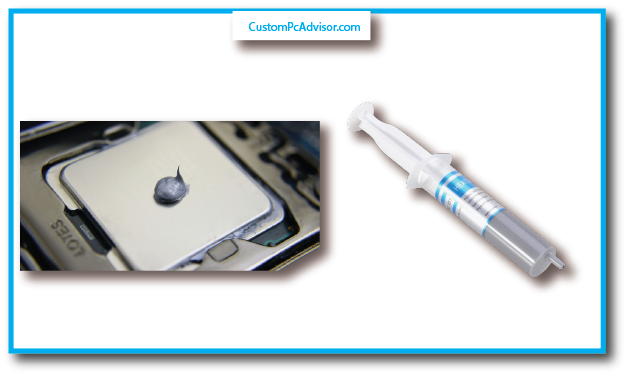
Alright, it’s time for a showdown in the world of CPU cooling. In one corner, we have the heavyweight champion, Liquid Metal, and in the other, the reliable and trustworthy Traditional Thermal Paste.
Let’s see who comes out on top!
Meet the Contenders:
Liquid Metal: This is like the Usain Bolt of thermal compounds. It’s made of metals like gallium, indium, and tin. The standout feature? Mind-blowing thermal conductivity, which
means it’s fantastic at whisking heat away from your CPU. But beware, it’s electrically conductive, so one false move, and you could have a tiny disaster on your hands.
Traditional Thermal Paste: The good old reliable buddy. Made from a mix of materials like silicone, zinc oxide, and aluminum, it’s not as flashy but gets the job done.
While it may not have the extreme thermal conductivity of liquid metal, it’s as safe as houses in the electrical conductivity department.
Face-Off: Liquid Metal vs Traditional Thermal Paste
Here’s a head-to-head comparison:
| Characteristic | Liquid Metal | Traditional Thermal Paste |
|---|---|---|
| Thermal conductivity | Very high | High |
| Electrical conductivity | Conductive | Non-conductive |
| Ease of application | Difficult | Easy |
| Price | Expensive | Affordable |
The Verdict:
Liquid Metal: If you’re gunning for absolute top-tier cooling performance, this is your go-to. It’s like giving your CPU a personal arctic breeze.
However, you’ll need steady hands because it’s a little tricky to apply.
Traditional Thermal Paste: If you’re all about that hassle-free, “can’t go wrong” life, this is your jam. It might not be as frosty as liquid metal,
but it’ll still keep your CPU at a comfy temperature.
Choosing Your Side For CPU
It all boils down to your needs and budget:
If you’re looking for that icy-cool, peak performance, and you’re confident in your steady hand skills, then give the liquid metal a whirl. Just be super careful to avoid any electric
mishaps. If you’re not quite ready for the liquid metal rollercoaster or if you’re budget-conscious, traditional thermal paste is your trusty sidekick. It’s like a good ol’ reliable sedan
in a world of sports cars. So, which side are you on? Liquid Metal for the thrill seekers, or Traditional Thermal Paste for the steady-and-sturdy types? Either way, your CPU will thank you for keeping it cool!
7. How To Make Thermal Paste On Your Own

Hello, DIY cooling adventurer! Ready to embark on a journey that’s equal parts science and quirkiness? Today, we’re going to dive into the eccentric world of DIY thermal paste.
But before we begin, a little heads-up: this homemade concoction might not outshine the big names in the market. But who cares? It’s all in the spirit of fun and experimentation!
Ingredients to Make Thermal Paste at Home
1 part aluminum powder (Find this at your trusty art supply store, and make sure it’s as fine as a secret agent on a mission.)
2 parts Vaseline oil (Pick up some pure Vaseline oil from your neighborhood drugstore, none of that fancy-schmancy, fragranced stuff.)
Instructions:
Roll up those lab sleeves and mix the aluminum powder and Vaseline oil. Stir like you’re concocting a magical potion, aiming for a smooth, creamy consistency.
Spread your unique concoction as a thin, cozy blanket on both your CPU and heatsink. It’s time to give your CPU a warm embrace.
Carefully attach the heatsink to the CPU, like reuniting long-lost friends. They’ll be hugging it out in no time!
Tips and Tricks for Your DIY Cooling Odyssey:
To ensure top-notch performance, go for that ultra-fine aluminum powder. We’re talking smoother than a silk sheet here.
When choosing Vaseline oil, pure is the way to go. None of that fancy, flowery stuff, please. We’re keeping it real.
Here’s the golden rule: less is more when it comes to DIY thermal paste. Overdoing it won’t win your CPU’s heart. It might give you the cold shoulder.
After whipping up your homemade paste, give it a spin. Test those CPU temperatures and see how they fare. If things get a little toasty, don’t be shy to call in the commercial thermal paste heroes.
Disclaimer To Make Thermal Paste On Your Own
This recipe is your fun little experiment, but it won’t be winning any CPU cooling championships. Think of it as the Robin to Batman, the trusty sidekick for your DIY projects.
So, when it comes to high performance machines or rigs tackling heavyweight tasks like gaming or video editing, it’s best to leave the cape-wearing to the superheroes.
What is a thermal paste, and why is it important for CPUs?
Thermal paste helps move heat from the CPU to the cooler, which stops the CPU from getting too hot.
Why do CPUs need thermal paste?
CPUs get hot when they work, and thermal paste fills tiny gaps to help cool them down better.
What are the main ingredients of thermal paste for CPUs?
Thermal paste usually has stuff like silicone or ceramics and metal bits to help heat move through it.
How does thermal conductivity affect the performance of CPU thermal paste?
If thermal paste conducts heat well, it cools the CPU better.
What are some common brands of thermal paste for CPUs?
Some well-known thermal paste brands are Arctic Silver, Noctua, and Thermal Grizzly.
Is there a difference between thermal paste for CPUs and GPUs?
They’re mostly the same, but some pastes might be made especially for CPUs or GPUs.
Can I use any thermal paste for my CPU, or should I choose a specific type?
It’s best to use paste made for CPUs to make sure it works right.
What factors should I consider when choosing thermal paste for my CPU?
Think about how well it conducts heat, how thick it is, how easy it is to put on, how long it lasts, and if it fits with your cooler.
Is there a difference between thermal paste and thermal pads for CPUs?
Yes, the paste is gooey and fills gaps, while the pads are solid and sit between the CPU and cooler.
How do I apply thermal paste to my CPU?
Put a small dot or line on the CPU, then press the cooler down to spread it out.
What is the proper amount of thermal paste to use on a CPU?
Usually, a small pea-sized dot or a thin line is enough.
Can I reuse thermal paste if I remove my CPU cooler?
It’s not a good idea to reuse paste because it won’t work as well the second time.
How often should I replace the thermal paste on my CPU?
Change it every few years or if your CPU starts getting hotter than it used to.
What are some signs that indicate I need to replace the thermal paste on my CPU?
If your CPU is hotter, the fan is louder, or the paste looks dry or cracked, it’s time for a new paste.
Can I mix different brands or types of thermal paste on my CPU?
It’s usually okay to mix them, but using just one kind is simpler and often works best.
Are there any precautions I should take when applying thermal paste to my CPU?
Yes, don’t touch it with your skin or clothes, make sure everything’s clean, and use just enough paste.
How can I remove the old thermal paste from my CPU?
Use rubbing alcohol and something that doesn’t leave lint, like a microfiber cloth, to gently clean it off.
Can I use thermal paste substitutes, such as toothpaste or mayonnaise, on my CPU?
No, don’t use those. They’re not made for the heat and could mess up your CPU.
What should I do if I accidentally get thermal paste on other components of my CPU?
Clean it off carefully with rubbing alcohol and a lint-free cloth, and be gentle with the parts.
Where can I find reliable information and tutorials on applying thermal paste to my CPU?
Look for how-to guides on trusted computer hardware sites, and forums, or watch tutorial videos on YouTube.
Conclusion
Sure thing! Think of thermal paste as the secret sauce for your computer’s brain (the CPU). It’s like the icing on the cake, but for your CPU. Picking the right thermal paste
and putting it on correctly is like giving your CPU a cozy blanket for its bedtime.Remember, different CPUs and coolers might have their own preferences,
like how some people like ketchup on their fries and others prefer mayo. So, always check what your CPU and cooler folks suggest – they’re the chefs in this kitchen,
after all!The bottom line is, that using the right thermal paste and applying it just right can help your CPU stay cool,
which means it won’t overheat and throw a temper tantrum. And that’s a recipe for a happy and stable computer.
FAQs
What is a thermal paste, and why do I need it for my CPU?
Think of thermal paste as the “coolant” for your CPU. It’s gooey stuff that helps your CPU stay chill. You need it to keep your computer from overheating, which can be bad news for your PC’s performance and lifespan.
How do I know which thermal paste to use?
It’s like picking the right seasoning for your dish! Check your CPU and cooler manuals for recommendations, as they have their taste in thermal paste. They’ll tell you what they prefer.
Can I use too much thermal paste?
Just like you wouldn’t put a whole bottle of ketchup on a single fry, don’t go overboard with thermal paste. A small amount, like a pea or rice grain, is usually enough. Using too much can make things worse.
Can I reuse thermal paste if I need to remove my CPU cooler?
Well, it’s like reusing gum you’ve already chewed. It’s not a great idea. Fresh paste works better. But if you have to, you can clean off the old paste and apply a new layer.
How often should I replace thermal paste?
Think of it like changing the oil in your car. You don’t need to do it every day, but every couple of years is a good rule of thumb. If your temps start getting too hot, that’s a sign it might be time for a change.
Can I use thermal paste for my laptop’s CPU too?
Yep, laptops have CPUs too! The same rules apply. If you want to keep your laptop cool, applying thermal paste correctly can help. Just be careful, laptops can be a bit trickier to take apart.

